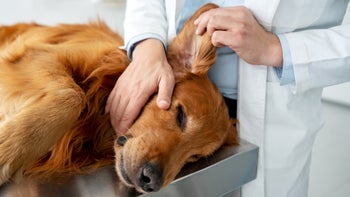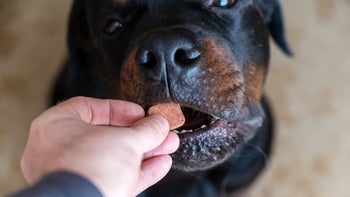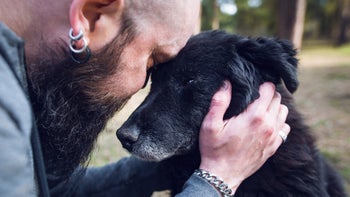
Lipomas in Dogs: What You Should Know About These Fatty Tumors
Key takeaways:
Lipomas in dogs are tumors made from a buildup of fat cells. In rare cases, they’re cancerous. But the majority are benign.
Lipomas typically feel soft and rubbery, though some can be firmer and less mobile.
The treatment is to have them surgically removed. But this isn’t always necessary.
Table of contents

Finding a lump on your dog can be scary. But many different conditions can cause a lump to form.
One type of lump is called a lipoma. Lipomas are tumors made of fat cells. They form when fat cells build up at a faster rate in a particular area.
Lipomas are usually benign, meaning they’re not cancerous and don’t spread to other areas of the body. But it’s still a good idea to keep an eye out for any new lumps and get your dog checked by a veterinarian.
Search and compare options
What are the symptoms of lipomas in dogs?
Lipomas are found directly under the skin or in the muscle. They can develop anywhere on a dog’s body. They usually feel like fatty lumps. You can feel them when you pet your dog.
Lipomas have a few notable characteristics, such as:
Moving around in place when you press on them
Rubbery, soft texture
Circular shape
Sometimes, lipomas might feel firmer and not move as much when you touch them. Their size depends on how many fat cells the tumor stores. If your dog is overweight, their lipomas are likely to be bigger. They could shrink if your dog loses weight. But they might not go away completely.
Once you become used to the feel of lipomas, it will probably be easier for you to tell if your dog develops more. But other tumors can mimic the feel of lipomas, including ones that are cancerous. So it’s best to take a trip to the vet to get new lumps checked, even if you’re pretty certain they’re lipomas.
What causes lipomas in dogs?
The exact cause of lipomas isn’t known. Some dogs might only develop a couple, while others develop several in various places on their bodies.
Managing your dog’s weight: Dogs who are overweight are at risk for developing other health conditions. Learn how to manage your dog’s weight.
Skin cancer in dogs: There are different skin cancers that can affect dogs. Here are the common symptoms (and treatments) for the most common types.
Mast cell tumors: Mast cell tumors are the most common skin cancer in dogs. They’re also one of the most treatable types of cancer.
Lipomas tend to occur most often in older female dogs, especially ones that are overweight. But they can also develop in middle-aged dogs.
Other times, a dog’s breed can put them at higher risk for developing lipomas. Some breeds that are more at risk are:
Doberman pinschers
Labrador retrievers
Miniature schnauzers
Mixed breeds
Read more like this
Explore these related articles, suggested for readers like you.
In some rare cases, lipomas can invade the tissue surrounding them. These are called infiltrative lipomas. They usually form on the legs and chest. Typically, they’re not confined to a circular shape like normal lipomas.
How are lipomas in dogs diagnosed?
To diagnose lipomas, most veterinarians use a small needle to remove sample material from the lumps and look for fat cells under a microscope. Many vets can do this themselves without having to send the samples off to another lab.
Under a microscope, the fat cells in lipomas, infiltrative lipomas, and liposarcomas look the same. But sometimes samples don’t clearly show fat cells. In this case, veterinarians may recommend a biopsy to rule out other conditions, such as a mast cell tumor.
Usually, the type of lipoma a dog has isn’t known until after surgery is performed. Many vets send lipomas off for biopsies to determine the type as a precaution. CT scans can also be useful in distinguishing between the tumor types.
Are lipomas in dogs cancerous?
Most lipomas in dogs are not cancerous. But liposarcomas are a very rare, cancerous version of lipomas. Liposarcomas can invade the surrounding tissue. But they don’t usually spread to other areas of the body.
Like infiltrative lipomas, liposarcomas tend to form on the legs and chest. Breeds with a higher risk of developing these cancerous lipomas are Shetland sheepdogs and beagles.
How do you treat lipomas in dogs?
Surgery to remove the tumor is the first-choice treatment for lipomas in dogs. Often, though, lipomas don’t need treatment and can be left alone. Many times, getting them removed is a cosmetic decision, since most lipomas don’t negatively impact a dog’s life.
But depending on where the lipomas is on your dog, your veterinarian may recommend surgery. Lipomas can grow in areas — such as the armpit or groin — that might make it difficult for your dog to walk or move. And they can grow in areas where they cause discomfort.
Some lipomas can grow into huge masses that put extra weight on your dog. In these cases, having them removed might be best for your dog’s comfort. Luckily, normal lipomas don’t usually grow back.
Too much weight on a dog can make it difficult to remove their lipomas. If your dog is overweight, your vet may recommend that they lose weight before surgery is performed.
If lipomas grow too large, they can be harder to remove with surgery. This can lead to complications, such as fluid gathering at the surgery site. And some lipomas don’t have clear edges, which can also make it harder for a veterinarian to remove them.
Treating infiltrative lipomas
If your dog’s lipoma is found, during surgery, to be infiltrative, your vet may have to remove tissue around the tumor. This is to make sure all of the tumor gets removed.
Since infiltrative lipomas grow into surrounding tissue, there is a chance they could grow back after surgery. Some vets might recommend radiation therapy after surgery to reduce this possibility.
Treating liposarcomas
Veterinarians almost always recommend surgery to prevent the spread of liposarcomas once they’re discovered. This requires the removal of a large amount of tissue around the tumor.
There is a high chance of liposarcomas growing back after surgery. Further surgeries or radiation treatment may be needed if they continue to return. Some vets may even do a combination of surgery and radiation. Depending on the severity, chemotherapy might also be recommended.
If liposarcomas aren’t removed quickly, they can continue to invade the surrounding tissue, which can make them harder to treat. In rare cases, liposarcomas can invade other areas, such as the lungs. Delaying treatment could give the cancer a chance to spread.
Can you prevent lipomas in dogs?
There isn’t a known way to prevent lipomas in dogs. But you might be able to lower their risk by keeping your dog at a healthy weight. And keeping up with their annual exams can help detect lipomas early.
Frequently asked questions
If the tumor is large or in an area that affects movement, an untreated lipoma could lead to your dog having trouble walking or standing. This could even make your pup reluctant to do their normal activities.
Infiltrative lipomas and liposarcomas can develop and put pressure on certain areas, such as the spine. They can also affect bones. If that happens, amputation may be necessary.
If your dog is overweight, their lipomas might shrink if they lose the excess weight. But they might not completely go away. Otherwise, there are no natural remedies to shrink a dog’s lipoma.
We don’t have any evidence that certain foods cause lipomas in dogs. What we do know is that dogs who are overweight are more likely to develop lipomas. So it’s best to keep your dog on a balanced diet and manage their weight.
The bottom line
Lipomas are benign tumors made up of fat cells. They grow under a dog’s skin and sometimes in the muscle. And most of them feel soft and rubbery.
The cause isn’t known, but some dogs are more likely to develop these tumors than others. In some cases, lipomas can invade the surrounding tissue. And they can also be cancerous in rare cases. But cancerous lipomas don’t usually spread throughout the body like other cancers.
It’s best to get lipomas diagnosed by your veterinarian. If they require treatment, they’ll be surgically removed.
Why trust our experts?



References
Brooks, W. (2023). Lipomas in dogs and cats. Veterinary Partner.
BSAVA Library. (n.d.). Chemotherapy protocols.
Hobert, M. K., et al. (2013). Infiltrative lipoma compressing the spinal cord in 2 large-breed dogs. The Canadian Veterinary Journal.
Johnson, T. (2017). Mostly, lipomas in dogs look bad but aren’t bad. VetzInsight.
Khuly, P. (n.d.). Lipoma in dogs. Embrace Pet Insurance.
Kirpensteijn, J. (2006). Sarcomas of soft tissues. World Small Animal Veterinary Association World Congress Proceedings.
North Carolina State Veterinary Hospital. (n.d.). Medical oncology: Canine soft tissue sarcoma. North Carolina State University College of Veterinary Medicine.
Spoldi, E., et al. (2016). Comparisons among computed tomographic features of adipose masses in dogs and cats. Veterinary Radiology & Ultrasound.
Villalobos, A. E. (2024). Tumors of the skin in dogs. MSD Veterinary Manual.
Yankowicz, S. (2024). Cytology for 3 common dermatological tumors. DVM360.




























